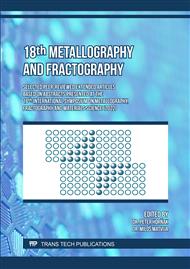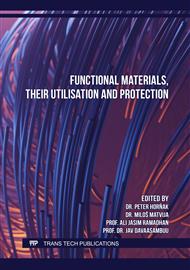[1]
Annual Activity Report 2020. (2020). https://www.clean-hydrogen.europa.eu/system/files/ 2021-06/FCH-20-001-Annual%2520report%25202020%2520%2528ID%252011531857%2529. pdf.
Google Scholar
[2]
IEA (2021), World Energy Model, IEA, Paris https://www.iea.org/reports/world-energy-model
Google Scholar
[3]
B. P. Tarasov et al., Metal hydride hydrogen storage and compression systems for energy storage technologies, Int. J. Hydrogen Energy 46 (25) (2021) 13647-13657.
DOI: 10.1016/j.ijhydene.2020.07.085
Google Scholar
[4]
K. Wu, B. Cai, L. Fan, L. Qin, D. Chen, and Y. Huang, Stress measurement of MlNi4.5Cr0.45Mn0.05 alloy during hydrogen absorption-desorption process in a cylindrical reactor, Int. J. Hydrogen Energy, 45 (52) (2020) 28175-28182.
DOI: 10.1016/j.ijhydene.2020.03.073
Google Scholar
[5]
M. Sahlberg, D. Karlsson, C. Zlotea, and U. Jansson, Superior hydrogen storage in high entropy alloys, pp.1-6, 2016.
DOI: 10.1038/srep36770
Google Scholar
[6]
Zhang, Y.O.N.G. High-entropy materials: A brief introduction. S.l., China: SPRINGER, 2020.
Google Scholar
[7]
Y. Zhang, et al., Solid-Solution Phase Formation Rules for Multi-component Alloys, Adv. Eng. Mater. 10 (6) (2008) 534.
Google Scholar
[8]
S. Guo, C. Ng, J. Lu, et al., Effect of valence electron concentration on stability of fcc or bcc phase in high entropy alloys. Journal of Applied Physics 109 (2011) 103505.
DOI: 10.1063/1.3587228
Google Scholar
[9]
S. Guo, C. T. Liu, Phase stability in high entropy alloys: Formation of solid-solution phase or amorphous phase. In Progress in Natural Science: Materials Internat. 21 (6) (2011) 433-446.
DOI: 10.1016/s1002-0071(12)60080-x
Google Scholar
[10]
M. M. Nygård, G. Ek, D. Karlsson, M. H. Sørby, M. Sahlberg, B. C. Hauback, Counting electrons - a new approach to tailor the hydrogen sorption properties of high-entropy alloys, Acta Mater. 175 (2019) 121-129. https://doi.org/10.1016/j. actamat.2019.06.002.
DOI: 10.1016/j.actamat.2019.06.002
Google Scholar
[11]
S. Guo, Q. Hu, C. Ng, C. T. Liu, More than entropy in high-entropy alloys: forming solid solutions or amorphous phase. Intermetallics 41 (2013) 96-103.
DOI: 10.1016/j.intermet.2013.05.002
Google Scholar
[12]
D. Dew-Hughes, The addition of Mn and Al to the hydriding compound FeTi: range of homogeneity and lattice parameters, Metall. Trans. A. 11 (1980) 1219-1225.
DOI: 10.1007/BF02668146
Google Scholar
[13]
J. A. van Beek, A. A. Kodentsov, F. J. J. van Loo, Phase equilibria in the Cu-Fe-Ti system at 1123 K, J. Alloys Compd. 217 (1995) 97-103. https://doi.org/.
DOI: 10.1016/0925-8388(94)01302-X
Google Scholar



